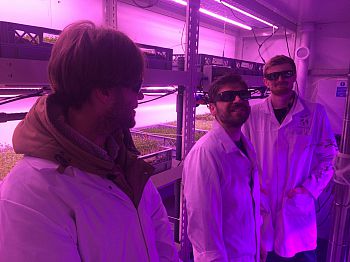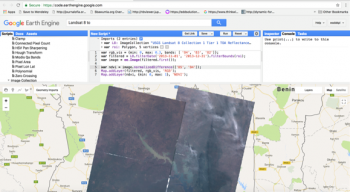- Using machine learning to automate flood simulations (Spin Out company)
-
Ambiental Environmental Assessment has teamed up with DataJavelin, a University of Sussex spin out company created through DISCUS, to explore how to automate the calibration of flood risk simulations through machine learning and Artificial Intelligence techniques.
Using machine learning to automate flood risk simulations from University of Sussex on Vimeo
- Making vertical farming stack up
-
The challenge
This project was undertaken with industrial partners LettUs Grow as part of an STFC Food Network scoping call.
Indoor farms, whether they be a greenhouse or vertical farm, require close control over a wide range of environmental variables. The temperature, humidity, and air flow around the plant shoots and roots is a crucial determinant of crop growth rate. These can be balanced alongside lighting, irrigation, and nutrient delivery, to generate the perfect microenvironment for individual plant species – and maximise growth rate within the facility. Similarly, while large facilities have the budget to purchase multi- million-pound solutions from factory automation experts, most vertical farmers do not have access to automated sowing, harvesting, or packaging machines. This results in prohibitively high labour costs, as employees are put to work cutting crops by hand.
The solution
We drafted observational models of an indoor growing facility, alongside both a literature-based and practical exploration of the use of probabilistic modelling to determine optimal growth conditions within an indoor farm.

The collaboration between LettUs Grow and our researchers has resulted in a significant amount of knowledge transfer, without which LettUs Grow wouldn’t have been able to properly inform their data strategy over the oncoming years of growth.
The team
- University of Sussex: Dr Adam Barrett, Prof. Seb Oliver
- LettUs Grow Ltd: Jack Farmer, Charlie Guy & Ben Crowther
- Data Javelin: Dr Philip Rooney, Dr Peter Hurley
- Searching for stunning images of beautiful locations
-
The challenge


Deckchair webcam technology provides live views and time-lapse videos of their client’s destinations in over 44 countries, ranging from hotels in the Arctic circle to cruise ships in the Atlantic.
Finding incredible images has enormous value to their clients to promote their destination but is a time-consuming human process.
Working with Deckchair, researchers and staff at DISCUS used their expertise to develop a workflow and AI methods and models for automating this otherwise time consuming human process.
The goals were to:
- Automatically detect interesting images from 24 hour time lapse images of a popular tourist location
- Partition data stream into interesting/non-interesting categories
- Classify and label content in both categories
The solution
A hack day bringing together astronomers, mathematical biologists and particle physicists from across the Univeristy of Sussex suggested a way to tackle the challenge and this then led to a longer project.
Our approaches included using:
- Structural Similarity Index Method (SSIM) used to detect global changes in images relative to a reference frame e.g. fireworks
- Dominant colour analysis to determine sunsets
- Transfer learning to fine-tune deep neural networks for classification
The results have enabled Deckchair to automatically select all interesting frames and classify them with high accuracy.
The team
- Colin Hayhurst, Innovations Partnership Fellow
- Yusufu Shehu, Postdoctoral Research Fellow in Data Science
- Fabrizio Miano, Postdoctoral Research Fellow in Data Science
- Using Astrophysics to Close the Diagnosis Gap for Dementia
-
The challenge
The Astrodem study uses techniques developed for studying galaxies to analyse anonymised patient records looking for the early warning signs of dementia.
Dementia is one of the greatest public health challenges of our era. There are an estimated 800,000 people with dementia in the UK and by 2021 this will increase to over 1 million. The impacdt of this disorder on patients, their carers, other family members and society is profound. Timely diagnosis allows patients to benefit from current therapies, plan for the future and maximise their quality of life. However, there is a 'diagnosis gap' in UK general practice, with less than two-thirds of expeted patients recieving a dementia diagnosis. Currently diagnosis occurs late or not at all and opportunities for therapeutic interventions are missed.
The solution
DISCUS researchers are employing statistical and machine learning techniques originally developed to for specifying and identifying galaxy 'finger-prints' and these same methods can enable epidemiological and health services researchers to exploit routine health data more effectively.
Physicists seek optimal techniques by applying methods that allow them to identify the same galaxy seen in pictures from different telescopes (data linkage), to find sets of galaxies that have similar properties and identiy the common features of galaxy 'finger-prints' (case-definition) and to create models of galaxies that predict some behaviour on the basis of other observations (predictive diagnostics). These techniques can be used on GP patient records where the clinical condition is analogous to a galaxy, the GP database to a galaxy catalogue and the diagnosis of a condition to the modelling of galaxy properties.
Outcomes
2018 publication: Ford, E., Greenslade, N., Paudyal, P., Bremner, S., Smith, H.E., Banerjee, S., Sadhwani, S., Rooney, P., Oliver, S. and Cassell, J. (2018). Predicting dementia from primary care records: a systematic review and meta-analysis. PLoS ONE 13(3): e0194735.
The Team
Dr Elizabeth Ford, Dr Phillip Rooney, Professor Seb Oliver, Professor Jackie Cassell, Professor Sube Banerjee, Dr Richard Hoile, Ms Shanu Sadwani, Dr Johannes Starlinger.
- Applying Astronomy Data Analyisis to Enhance Disaster Forecasting (AstroCast)
-
 Livestock accounts for 37.5% of Kenya's land area, 12% of its GDP and 40% of its agricultural sector, but is susceptible to frequent droughts and periods of overgrazing. In this context, this project will assess the potential of new Earth observation datasets to deliver near real-time monitoring and prediction of useful and accessible biomass for pastoralism. Drought and flood events are a major threat in sub-Saharan Africa (SSA) causing substantial losses of life, assets and livelihoods, and weakened national economic performance. Hazard early warning and disaster risk preparedness actions can be effective in reducing these losses (as much as 20 times more effective than post-disaster relief). In this project we will apply advanced data analysis techniques used in astronomy to facilitate improved hazard early warning models in Kenya.
Livestock accounts for 37.5% of Kenya's land area, 12% of its GDP and 40% of its agricultural sector, but is susceptible to frequent droughts and periods of overgrazing. In this context, this project will assess the potential of new Earth observation datasets to deliver near real-time monitoring and prediction of useful and accessible biomass for pastoralism. Drought and flood events are a major threat in sub-Saharan Africa (SSA) causing substantial losses of life, assets and livelihoods, and weakened national economic performance. Hazard early warning and disaster risk preparedness actions can be effective in reducing these losses (as much as 20 times more effective than post-disaster relief). In this project we will apply advanced data analysis techniques used in astronomy to facilitate improved hazard early warning models in Kenya.This pilot project brings together STFC funded Astronomers at University of Sussex with a strong track record in data analysis with a world-leading interdisciplinary team in Climate Change and Developmental studies.
The Solution
We collected both MODIS (500m resolution) and Landsat (30m resolution) Earth Observation data for the different vegetational regions (See Figure 1) of Kenya since 2000, providing us with a large temporal range, which is necessary to train our forecasting models. We have used Gaussian processes to interpolate the missing temporal data, which are robust to missing data and flexible to richly varying data.
The Gaussian Processes developed will also be used as a prototype for an empirical forecasting model of both Normalized Difference Vegetation Index (NDVI) and VCI (Vegetation Condition Index). Simultaneously we have developed a forecasting model using Granger Causality to predict the future state of the pastural regions we monitor. We have used the monthly, county-based VCI data points assembled by the Kenya National Drought Management Authority (NDMA) to test our forecasting method. By fitting a simple linear autoregressive model to several years of past data (See Figure 2), and then projecting this model one month into the future, we have already obtained a 60% to 70% reduction in uncertainty (with respect to the natural standard deviation). The advantage of both the Gaussian processes and Granger causality is that multidimensional data can be included and simultaneously fitted/modelled.
Proposed Outcome
The ultimate outcome of this research will support pastoralist communities in Kenya, to decide the suitability and location of pastureland for their various livestock through: a) improved understanding of spatio-temporal distribution of pastures; b) improved understanding of ecological changes and resilience of pastures; and c) near-future predictions of pasture suitability. This will enhance their livelihood resilience in the wake of large and extensive droughts, overgrazing, and land cover change.
The team
The Project was awarded £100k funding from the STFC Global Challenge Research Fund and an additional £15k was awarded from the STFC GCRF institutional award.
The team consists of two postdocs, Dr Adam Barrett and Dr Steven Duivenvoorden with an additional PhD student, Edward Efui Salakpi, funded by the Newton Fund DARA project.
The project is guided by experienced members of staff, Prof Seb Oliver (Astrophysics and Data Analysis), Dr Pedram Rowhani (Remote Sensing and International Development) and Prof Martin Todd (Climate Change).
- Identification of Targets in Gene Expression - Hackday
-
The challenge
Dr. Chris Jones of the Brighton and Sussex Medical School asked the hackers to help him identify mRNA degradation targets in gene expression. For the group of students the first step was to try and understand the problem, the terms and language of another field and the large genome datasets provided. They had one day to find a promising solution.
The solution
This problem was tackled by five researchers from three different disciplines: two from Physics, two from Mathematics and one from Informatics. They quickly coded up a way to extract and process the data and then visualise read distributions for each gene. They then had to design and code an algorithm for identifying candidate genes. At the end of the day they had identified 25 initial candidate genes and a method to find more.
Dr. Jones said “I was amazed at how quickly the team were able to develop code to tackle my research challenge. In a few hours they understood my data and research topic and came up with a solution that I could not have contemplated before this hack day. It’s likely that we can put together a paper about this with some experimental validation work that I can now contemplate doing”.
- Visualization and Navigation of Galaxy Datasets - Hackday
-
The challenge
Prof. Seb Oliver asked hack day participants to develop software which would enable anybody to navigate around a 3D map of the real universe, and in the process access up-to-date and real astronomical research data developed by the Astronomy group and other groups worldwide through the Virtual Observatory. The biggest challenge they faced here was with multiple messy datasets.
The solution
The team developed a tool to visualise galaxy data, a web app to fly through a section of the universe with 300,000 galaxies and a way to locate the galaxies and serve up images of that galaxy from another dataset.
Seb Oliver commented “What the students achieved in one day is hugely impressive. It has raised my expectations of what a group of talented developers can do and opens up new avenues to make our research more accessible to a wider audience”.
- Text Analysis Group at the University of Sussex
-
The Text Analysis Group (TAG) Laboratory is part of a long line of AI research at Sussex, starting in the 1960s. We conduct research in NLP, the analysis of text and language by computers, and apply these technologies to the interpretation of text documents, social media and other communications, working with business, government and others.
Visit the TAG Laboratory website to find out more about current projects including:
- Predictive Analytics Lab at the University of Sussex
-
The Predicative Analytics Lab (PAL) undertakes high quality machine learning / computer vision research to provide support to a new generation of technology companies.
The PAL laboratory was co-founded by Novi Quadrianto and Jeremy Reffin on 7th February 2017 and has a team of 10 members consisting of faculty, research fellows, research associates and PhD students.
Visit the PAL website to find out more about current projects including:
-
ETHICAL MACHINE LEARNING: Injecting Ethical and Legal Constraints into Machine Learning Models
-
ML4PXP: Causal machine learning for development data
-
SATELLITE IMAGE SEGMENTATION: Understanding trade-offs between SDG's in urbanising contexts
-


